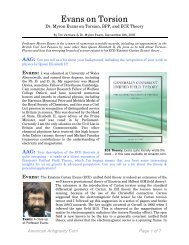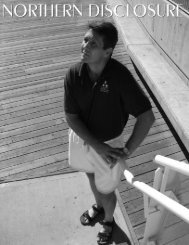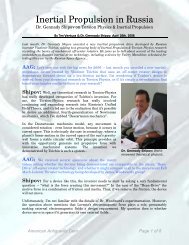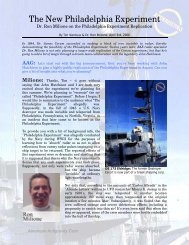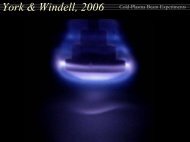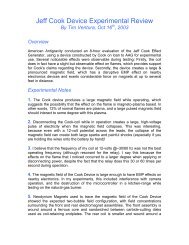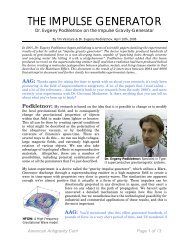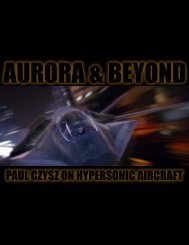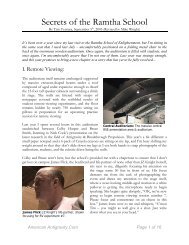American Antigravity interview - Petar Bosnic Petrus
American Antigravity interview - Petar Bosnic Petrus
American Antigravity interview - Petar Bosnic Petrus
You also want an ePaper? Increase the reach of your titles
YUMPU automatically turns print PDFs into web optimized ePapers that Google loves.
Gravifugal Force<strong>Petar</strong> <strong>Bosnic</strong> on Reactionless PropulsionBy Tim Ventura &Dr. <strong>Petar</strong> <strong>Bosnic</strong>, January 25th, 2006If satellites were motionless, they would rapidly plummet to Earth - but they don't because of a magicratio between forward velocity and the rate at which they fall, giving them a stable orbit at any altitude.This concept captivated Professor <strong>Petar</strong> <strong>Bosnic</strong>, leading him to a simple question: could a rapidlyrotating ring create lift in the same manner that a satellite remains in free-fall? He joins us to talk abouthis vision for a new propulsion from the concept of “Gravifugal Force”…AAG: Let's begin with your background: can you tell us a bit about your background &education, and how you first got involved with BPP research?<strong>Bosnic</strong>: Well, I’m a professor of philosophyand art history, but from an early age, mathematicsand physics were my hobby. In 1968 I started toexperiment with levitation devices. It was during1975 that I got the first affirmative results in thelaboratories of "Tehnoloski fakultet" - University ofZagreb. At the time, though, I couldn’t explain theresults, and I temporary stopped conducting myresearch. In 1982 I discovered the "double curvedtrajectory of a ring mass rotating in a gravitationalfield", and made calculations based on a hypothesisof gravifugal force that explained my experimentalresults. After I completed developing the theory Ihad no further theoretical or technologicalproblems.AAG: Now on your website, you clearly stateyour belief that "<strong>Antigravity</strong> does not exist" -- butyou're proposing another effect to accomplish areactionless thrust. Can you tell us about"Gravifugal Force"?Flying Ring: Could <strong>Bosnic</strong>’s Gravifugal Forcelead to the development of giant ring-craft?<strong>Bosnic</strong>: I’m educated in relativity and quantum physics and other fields, but I do not seethe place of antigravity. Maybe it is good luck, because such a force would likely decreaseproportionally to the radius squared of the distance from Earth’s center. Gravifugal forcedecreases linearly, which makes it much more powerful andsuitable for propulsion than this hypothetical antigravity forcewould be. It’s good luck that I pursued the research that I did…Free Fall: Satellites inorbit are always falling.Hypothetically, <strong>Antigravity</strong> "should be" one of fundamental forces.In contrast, gravifugal force is just a reaction to action of gravipetalforce. Gravipetal force is a gravity functioning as a centripetal force.Astronauts and him spaceships e.g. are subjected to the gravipetalforce, which continuously bends their trajectory into circular shape.The reactionary force is “gravifugal”, which allows the levitation ofastronauts and their spacecraft.<strong>American</strong> <strong>Antigravity</strong>.Com Page 1 of 6
AAG: It appears that you're working from a Newtonian Physics playbook in your derivations.Have you investigated hyper- and multidimensional models of spin such as Torsion Physics?<strong>Bosnic</strong>: Yes, but I haven’t published the results of my research into Torsion Physics --making it public just isn’t a high priority for me at the moment. Tesla also conducted research inthis area. The value of torsion effects in gravitational and magnetic fields are very small, but it’spossible to detect Torsion fields over very long distances.The connection between force & rotation was detected a long time ago in the Earth’s rotationand measured by a gravimeter with a very high degree of accuracy. Unfortunately it waserroneously regarded as a derivative of geocentrifugal force. Actually, geocentrifugal force is aderivative of gravifugal force.AAG: One force that you stress in particular is the "axilongal force", acting along the axis of arotating body. Are you saying that a rotating object can experience an upward or downwardthrust along the axis of rotation resulting from the energy of spin itself?<strong>Bosnic</strong>: Axilongal force appears inrotation within a gravitational field. A solidbody rotating doesn’t cause axilongal forcebecause of the principle of symmetry. (seefigure 1)This force is a derivative of gravifugal forceand direct cause of levitation. I am very gladto say that it was proved by falling down ofspinning gyroscopes, but in the lack ofgravifugal force theory it was not possible toexplain the results. So, unfortunatelyFigure 1: The resulting forces in the rotation of asteel sphere, and the forces a celestial body.achieved small values were regarded as measurement errors. The clearest results were achievedby Dr. Hideo Hayasaka.AAG: Thus far, your work seems firmly rooted in Newtonian Physics, and most of the<strong>Antigravity</strong> research that I've seen is from relativity or Unified Field & Torsion Physics. Is it fairto say that "<strong>Antigravity</strong> doesn't exist" really applies more to your model than to physics itself?<strong>Bosnic</strong>: Maybe your objection is correct, but I remain satisfied that gravifugal force is still amuch more powerful and suitable than I believe antigravity would be. However, sometimes I feelfrustrated at the realization of just how simple the model of gravifugal force is, and wish thatmore people could accept it on its many merits. Remember, the experimental evidence forgravifugal force was found long ago, and my primary contribution rests only in determining thecorrect model to explain the existing evidence. In my case, the discovery leads to the concept ofthe double curved trajectory of a rotating ring mass – but this concept is very important. It’spossible that it’s even more important than the spherical geometry of Riemann and Lobacevskij.AAG: OK, so let's talk propulsion: you've written about asking the reader to imagine arotating ring sitting above a ball, which has a double-curved trajectory of the ring mass. Thisseems to involve an aspect of your actual propulsion concept, so can I ask you to elaborate onthis a bit?<strong>American</strong> <strong>Antigravity</strong>.Com Page 2 of 6
<strong>Bosnic</strong>: Let me correct a misperception – the"ball" you’re referring to is in fact the Earth, but thespecific graphic you mentioned online containsinadequate proportions between the Earth andring. The trajectory of the rotating ring mass issimultaneously curved to the center of ring and thecenter of gravity of Earth – the point of applicationfor gravipetal force. Figure 8 below contains anexplanation for this based in Euclidean geometry.(see figure 2)AAG: From a layman's perspective, the momentthat I saw the schematic of a ring rotating above aball, it struck me that you were suggesting that ifthe ring rotates faster than it's escape-velocity thatit won't fall for the same reasons a satellite stays inorbit...in other words, a ground-level free-fall. Isthis accurate, or am I way off base?Figure 2: The orientation of a gravifugalring-craft shown on the Earth’s surface.<strong>Bosnic</strong>: Quite correct. That velocity is thevelocity of a satellite in stable “free-fall”. At thatvelocity, mass develops gravifugal force that equalsthat of gravipetal, and because of it astronauts andtheir spacecraft don’t falling to the Earth’s surface.Perhaps it would be more appropriate to say thatthey do fall, but never reach the surface because ofthe velocity. The velocity to levitate a low-altitudering is a negligibly higher than that of astronauts.AAG: The ring that you're proposing isn't large,is it? You're talking about something between 1 and20 meters in diameter, rotating at a speed of 7,900meters per second. Can you describe theconstruction of this device for us, and some of thechallenges in materials-stress & energyconsumptionthat are involved with that kind ofrotation speed?The Big Idea: Can a high-speed rotatingring attain a free-fall levitation effect?<strong>Bosnic</strong>: Not 1-meter, but rather 10, 20, or 50meters in diameter. The actual size depends mostlythe device’s purpose & primary application. Thelowest velocity should be 7900 m/sec. (It is velocityto achieve the free-fall levitation effect). The ringmust be constructed from nano-tubes, becauseother materials are probably not enough strong.The ring is accelerated by electrical energytransformed into Tesla’s rotational electromagneticfield, just like a conventional motor.<strong>American</strong> <strong>Antigravity</strong>.Com Page 3 of 6
AAG: Assuming that we've got your prototype Gravifugal Craft powered-up and ready to go,what kind of output thrust are we looking at, and does it remain constant with altitude, orpossibly decline as the distance from Earth increases?<strong>Bosnic</strong>: Very good question! Gravifugal (vertical) acceleration of the craft is not constant. Itis increases with increasing altitude (the distance from Earth’s center). That is what makes thegravifugal force more powerful and suitable for propulsion than an antigravity effect.Conversely, if we want to avoid gravifugal acceleration, we must decrease the velocity of ring.Decreasing the rotation would decrease thrust, which would be a requirement when landing thecraft. This phenomenon is already well-known in astronautical science. A gravifugal craft issubject to the same laws as any conventional spacecraft.AAG: Speaking of which, the free-fall effect that I mentioned earlier makes sense within theEarth's gravity-well, but would this thrust continue after we've left the Earth's gravity-field -- sayat something like a Lagrange point between the Earth and the Moon?<strong>Bosnic</strong>: Well, at that point behavior of a gravifugal craft becomes equal to the behavior of a"classical" spacecraft.AAG: Now in addition to the ring, wouldyou require some type of special apparatusto turn the craft for directional control? Canyou tell us how you'd change orientation,especially given a rotating body's resistanceto a change of aspect?<strong>Bosnic</strong>: The gravifugal force itself onlyenables vertical thrust. This lets a craftattain or to stay at a given altitude over thesurface of Earth or any other celestial body.For movement in other directions isnecessary to use another type of engine.AAG: Your research, based on satelliteobservations, indicates that the GravifugalCraft could generate tremendous thrust, butwouldn't defy the basic conservation ofenergy laws. Can you elaborate on this?Force Axis: The axis of thrust is perpendicular tothe plane of rotation, away from the Earth’s center.<strong>Bosnic</strong>: "Tremendous" ?!?! It would be better to say “very big” or “large” …or try “severalmillions of kilo-pounds of thrust” if made with the strongest materials available today. Thiswould include a craft specially fitted with a quantum ring – but despite this massive force, thecraft doesn’t violate any conservation of energy laws. However, it would be efficient enough toget to orbit several times in one day. Electrical energy is used to accelerate the ring and lift upthe craft.The beauty of the concept is that the ring stores energy like a flywheel – when you want to landthe craft, you can decelerate the ring by using it as a generator, which transforms its kineticenergy back into electrical energy for storage in a battery-bank. To get back into orbit again, yousimply use the stored energy, thereby saving everything except friction-losses in the process.<strong>American</strong> <strong>Antigravity</strong>.Com Page 4 of 6
gravifugal thrust for this standing wave is very large!AAG: As the ring begins to accelerate, do you notice a gradual decrease in weight, or does itsuddenly take off without warning? You've indicated that the propulsion begins once the velocityof the ring exceeds the rotational speed of the Earth, and I'm wondering if you could walk usthrough the process of what the power-up & liftoff process might be like?<strong>Bosnic</strong>: The reduction in weight occurs gradually. At the required minimum “free-fall”velocity, the ring loses all of its weight. If we further increase its velocity the ring begins to pressthe magnetic field of its casing over itself and starts to lift of the craft - also gradually. The casingand construction of the craft do not rotate themselves, only the ring inside does.AAG: You've got three designs publishedonline for prototyping: first, a conventionalelectromagnetic motor, and second, a motorusing permanent magnets to increase themotor's efficiency. Design number 3 is trulyunique, though -- you've describedsomething using a "Quantum Ring", whichis a ring made of pure light. Can you tell usabout this concept, and how it workswithout a massive ring?<strong>Bosnic</strong>: I’ve already addressed thatquestion above, but see my website for moredetailed information.AAG: Let's close with your contact info -- what's the best way for people to get intouch with you, and where can they learnmore about your research?Gravifugal Craft: A rendering of what a full-scalegravifugal craft might look like (minus the turbolift).<strong>Bosnic</strong>: The best way for anybodyserious to contact me is by normal snailmail.Unfortunately, my email box is oftenfull of spam and other rubbish, and I worryabout losing serious messages about thisresearch. Additionally, I’ve also published abook on the topic entitled – “New Physics”.You can buy it by internet using thekeywords <strong>Petar</strong> <strong>Bosnic</strong> <strong>Petrus</strong> New Physics.[Click here for more information]<strong>Petar</strong> <strong>Bosnic</strong> is an independent inventor & professor of the arts living in Croatia, Hrvatska. Hisfocus includes applying the principles mechanical engineering to innovative propulsiontechnologies. You can learn more about his research online at the following URL: <strong>Petar</strong> <strong>Bosnic</strong>Online<strong>American</strong> <strong>Antigravity</strong>.Com Page 6 of 6



